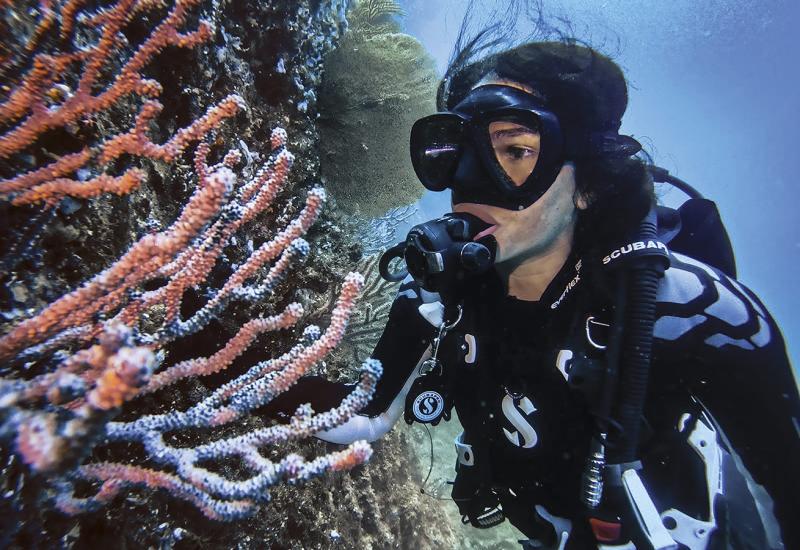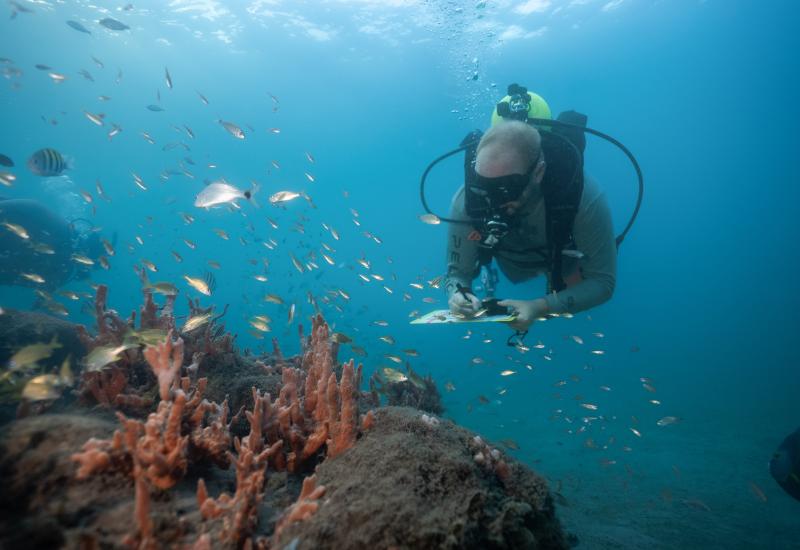Men In Green

Photo: SRC divers take advantage of low tide to map the remains of the ferry Ellis Island.
It's a pretty weird dive site, Ellis Island National Monument, but I have to admit the topside scenery is spectacular. Hard by rises the verdigris-colored colossus of the Statue of Liberty. Beyond, in stunning chiaroscuro, juts the august complexity of the Manhattan skyline. And here comes another Circle Line ferry, packed with tourists, churning into the ferry channel. Blatting a Bronx cheer, the ferry docks along the seawall, while its wake rocks the floating dock where we're suiting up in body-condoms for a plunge into the confused and probably toxic water.
Ah, New York City — what a place to dive!
So maybe Ellis Island will never fly the "diver down" flag of recreational diving. Nonetheless, it's the resting place of a significant shipwreck, that of its own eponymous ferry, the Ellis Island, a workhorse of America's great immigrant experience. While Ellis Island (the buildings and grounds) undergoes a huge restoration — at $156 million so far, the costliest in U.S. history — the ferry Ellis Island lies in shallow water, showing a conspicuously disintegrating gunnel at low tide. Enter the National Park Service's elite underwater trouble-shooters, the Submerged Resources Center. Their mission: map the wreck and recommend what to do about it. It's a complex, dirty job — but nothing unusual for the SRC team.
"It's just like in a 'Doc Savage' novel," says Dave Conlin, the perpetually upbeat, 37-year-old SRC archeologist in charge of the ferry project. "There's Ox, the iron-muscled Norwegian, expert in demolitions ..."
"Actually, I'm the Sgt. Bilko of the outfit," photographer/videographer Brett Seymour jokes back. "I find ingenious ways to requisition all the latest cool gear."
Conlin's tongue is firmly in cheek, but like the fictional hero Savage and his band of improbably adept warriors, the SRC divers combine brain, brawn and technology to an impressive degree. He is "Doc" Conlin, after all, a Ph.D. in maritime archeology. His SRC partners here on Ellis Island, fellow maritime archeologist Matt Russell and Seymour, are also highly accomplished divers and experts at their specialties.
"It's a Passion"
||
|---|
|

|
| Dan Lenihan videotapes the bridge of the USS Saratoga at Bikini Atoll.|
The civil service classification for what Conlin and Russell do is park ranger/archeologist. Seymour's classification is audiovisual production specialist. But their jobs could be described as professional adventurer. In addition to surveying and interpreting the archeological treasures of more than four million acres of submerged park service land, the team is often called on to dive Uncle Sam's historic shipwrecks wherever they've landed under water.
Dressed in their green polyester ranger uniforms, the SRC divers travel the world — from Maine to Key Biscayne; from the California Channel Islands to the English Channel; from the Bering Strait to Micronesia — wherever and whenever they're needed.
Most have advanced degrees in archeology and anthropology, but team members must be highly skilled divers first and foremost. The SRC team responds to any situation under water, whether it's deep decompression diving with double tanks and Geiger counters to test for radioactivity at Bikini Atoll, or dry suit diving on wrecks under the ice of the Great Lakes, or searching the dark depths of a desert reservoir for a drowning victim.
Only the pace is constant: In an average year, SRC divers spend six months on the road together — as much as a hard-touring rock and roll band. And like rockers, they have great jobs and they know it.
"It's not a job, it's a commitment. It's a passion," says founder Daniel Lenihan, now semi-retired but still active with the unit. "If you don't have a little bit of outrageousness in you, you aren't going to make it in this team. We only know how to work full throttle. I suppose we could be reasonable about it, but then that wouldn't be the team."
As Russell changes out of his ranger duds and into the quilted long johns he'll wear under his dry suit, he tells me about some beautiful dives he did recently in Glacier National Park, on ferry wrecks from the turn of the last century. Besides the amazing diving, the thing Russell loves most about the job is the challenge of doing something difficult and doing it well.
And about this New York ferry we're about to dive?
"This one's challenging," Russell tells me, grinning.
From the Caves of Florida
||
|---|
|

|
| Out of respect for the sailors entombed inside the USS Arizona, the SRC team uses remotely operated vehicles to explore the wreck's interior.|
The Submerged Resources Center traces its roots back to a couple of colorful, well-matched dive buddies, Daniel Lenihan and Larry Murphy, both of whom had been "campus radicals of one sort or another in the 1960s," as Lenihan writes in his history of the group, Submerged. Lenihan, a native New Yorker, studied archeology at Florida State in Tallahassee, where nearby sinkholes and caves promised Indian artifacts and the bones of wooly mammoths. By the early '70s, Lenihan was diving with cave pioneers Sheck Exley and Tom Mount inside some of the hairiest limestone mazes in the world.
Murphy was a trained commercial diver and passionate underwater preservationist, who took cave training from Lenihan for his job with the state archeologist's office and became a convert to the cave cult.
They teamed up for the National Park Service in 1976 on a four-year underwater archeological survey of flooded reservoirs in the southwest, a project headed by Lenihan. The National Reservoir Inundation Study called for repetitive high-altitude diving in frigid, low-vis water. Lenihan, Murphy and the team they trained used cave diving techniques, cave diving discipline and even the same #18 braided-nylon line (standard issue in Florida caves) to guide them in the chilling murk.
The success of NRIS won Lenihan the job of directing a permanent team of diving rangers, the Submerged Cultural Resources Unit (with the beloved acronym S.C.R.U.), now the Submerged Resources Center. The SRC has since archeologized on such storied wrecks as the giant aircraft carrier Saratoga, sunk during A-bomb tests off Bikini Atoll. Their mission to map, illustrate and test the wreck-strewn site for radioactivity opened up one of the world's greatest playgrounds for advanced recreational divers.
An ongoing project of equal scope — but greater pathos — has been the SRC's study of the battleship Arizona in Pearl Harbor. The tomb of more than 1,000 young servicemen, the wreck also holds a large quantity of toxic Bunker C fuel oil that continues to weep a few drops at a time into the harbor water. Using tried-and-true tools — lines, tapes and brow-crinkling trigonometry — the SRC mapped the exterior (the largest underwater structure ever mapped in such exacting detail). Ongoing surveys of the interior employ state-of-the-art remotely operated vehicles (ROVs).
The SRC team also surveyed the wreck of the Civil War submarine H.L. Hunley, paving the way for one of the most complex and expensive recovery operations in the history of underwater archeology — raising and conserving the vessel intact.
In between headline-grabbing expeditions, SRC divers have also led risky body recovery missions (Lenihan and Murphy's dives inside the works of a Texas dam, described in Submerged, are about as scary as it gets); pioneered vehicular rescue techniques (when good boat launches go bad); certified scores of fellow NPS rangers (the SRC team are all diving instructors); been featured in documentaries by the BBC, National Geographic and The Discovery Channel, among others; and won academic prizes for their archeology along the way.
Esprit de Corps
||
|---|
|

|
| Suiting up: Dave Conlin prepares for another day in the murk of the abandoned ferry slip.|
Though the core SRC team remains tiny--just the four archeologists Lenihan, Murphy, Conlin and Russell, plus Seymour, the man behind the lens, and an office manager, Fran Day--it can flex its muscles with volunteers and temps, drawing on the services of an ever more amphibious Park Service some 3,500 rangers strong.
The team I met one steamy morning in mid-July included five men in green: the three SRC guys, plus two veteran rangers on loan — Art Ireland, a nondiving surveying expert, and Jim Bradford, an artful underwater mapmaker. Rounding out the crew were interns Jackie Piero and general gofer Brendan Lenihan (Dan Lenihan's son), who was stoked to answer to "Copy Boy" so long as his duties also included diving.
They'd been hammering on the ferry project since April, and Conlin and Ireland were surveying the old broken pier that fans out from the ferry house. The wreck itself had been conceptually divided into 83 equal-sized panels. Jackie Piero and Jim Bradford were blowing bubbles in murk, plugging away with mapmaker's tape and slate at a panel in the high 70s. Brett Seymour and Brendan Lenihan dived in to recover artifacts. Matt Russell drew the short straw: media tour guide.
Swimming to Ellis Island
"Ready?" Russell asks. I flash the OK signal and we slip into the waters of the Golden Portal like a couple of wharf rats.
The near opacity of the ferry channel is immediately disorienting. We swim through untold shades of brown, bright caramel brown near the surface, with shining bits of particulate matter wildly swirling, a darker brown down deeper. Russell's flippers flee ahead of me in the gloom and I follow them like a remora. At 12 feet we kneel on the sucking mud of the bottom, which is very brown indeed.
Our full facemasks, equipped with two-way radios, allow us to converse.
RUSSELL: Well, this is it.
ME: Where?
RUSSELL: Right here, in front of us.
I move my face forward cautiously and — clunk! — there it is. A tiny patch of rusty hull is suddenly visible: craters of corrosion, a nut on a bolt. Move back a couple of inches and it's gone again. From the little I can see, I can't help thinking what a shame that it's come to this. The Ellis Island, a 140-foot, double-bowed passenger ferry, carried some 15 million striving souls from this ferry depot to the freedom, opportunity and laissez-faire mayhem of Lower Manhattan.
In 1954, the U.S. government abandoned Ellis Island — lock, stock and barrel-vaulted Registry Room. Just turned a key and walked. The Ellis Island rode out a decade of winter storms before listing terminally and hunkering down into the muck in 1968. A tropical storm in 1982 demolished the wooden superstructure, sweeping away much obvious historical charm. A mere shell now, it's all but lost to time.
Russell is currently mapping the boiler — panel #77 — which from what I can see of it looks like the business end of a cement mixer that's been stomped by Godzilla. It's shallow and surgy here, the boiler a jumble of rusty, sharp edges fading in and out of sight. The last couple of days Russell has spent long hours hovering above it with tape and slate, limning its every beat-up inch.
Unlike the three blind men in the famous Hindu parable of the elephant, these SRC guys are used to working by touch — and getting solid results. Dave Conlin tells a story about the Hunley mission. He and Matt Russell had to improvise a way to measure the diameter and shape of the hull, which lay five feet below bottom in a newly dredged hole in Charleston Harbor. The vis was zippo. He and Russell came up with a device — "a definite Rube Goldberg, Frankenstein's monster, PVC pipe kinda kludged together sort of deal, a real SRC special." Working blind and upside down with the contraption and a folding plastic ruler, Russell and Conlin came up with a hull height of four feet, three inches. That seemed awfully small; plus, the historical record stated that the sub was five feet high.
Four years later, Russell, Conlin and Seymour were back in Charleston when the Hunley was raised. "The sub broke the surface and was placed, unharmed, on a barge," recalls Conlin. "My overwhelming reaction was 'Damn, that thing is tiny.' Four feet, three inches tall, to be exact."
Yessiree, the SRC team is gonna know if it's an elephant all right, and there'll be a written report, an electronic data base, and a portfolio of photo and video images to back up the claim. What's even more impressive, though, is that they're going to recommend what to do about the brute.
A Form of Omniscience
"Dynamite it, right?" I say to Conlin. It's a couple of hours after my dive and I've had time to process all the data I need on the Ellis Island. "Cut it up with blow torches and haul it to deeper water."
Conlin chuckles indulgently. "Come on. I'll show you a little of what we've got."
I follow him into one of the wings of the restored Main Building to an upstairs room the SRC is using as its on-site office. Conlin sits at a laptop and starts clicking on icons.
There's Ellis Island, as seen from above, its man-made logic revealed — two islets, like the lobes of a brain, with the ferry channel neatly bisecting the two halves.
Click!
There's the ferry channel enlarged, with magnetometer readings overlaid, the lozenge-shaped ferry glowing in bright magenta.
Click!
There's an underwater view of the wreck, as pictured by side-scan sonar, peaks and valleys like an EEG.
Click!
There's the broken pier — a work in progress — rendered as a precision line drawing. An exact and complex portrait of pick-up sticks.
Conlin puts the program through a few more paces, rotating, enlarging, shrinking, showing various combinations of overlays. It's not quite omniscience, but a form thereof, and certainly a great deal more than I'd have guessed could be known about a blackwater wreck.
All in a Day's Work
It's late in the afternoon and everybody's out of the water. They're all about to pack up the gear and head for the office to download and debrief when a teacher approaches with about a dozen kids from a school for the deaf. The kids volunteered to do various jobs around the park, and Dave Conlin offered to give them a little demonstration of the project. The teacher translates with sign language as Conlin speaks.
"You'd all be good at this because we use a lot of signs under water," Conlin says. "Can you guess what this means?" He signs a few familiar ones. OK. Stop. Up. Then slashes his hand across his throat. There's a lot of laughter. Kids are signing like crazy. They know that one too.
Brett brings out his Nikon and lets them look through the lens. Matt writes on his erasable slate, shows them a few others crowded with data. One of the kids volunteers to try on a dry suit. Another, hooting with pleasure, dons a full facemask.
In a week or so, Brett will be joining up with Daniel Lenihan and some other rangers to dive the cold currents of the Pacific Northwest — an exploration trip. A little later, Matt's off to Hawaii and the challenge of the Arizona, still oozing bunker C fuel into Pearl Harbor. In the fall, Dave and the rest of the SRC crew is headed to the North Sea off the Yorkshire coast to look for the wreck of John Paul Jones's Bon Homme Richard.
Whatever their future adventures, I know I'm seeing the SRC at its multitasking best — doing preservation, facilitation, education, and just plain making friends with a curious public hungry for knowledge.
"Each project has its rewards," Conlin told me earlier, "and each one produces surprises. The things you think will be dramatic often turn out mundane, and the things you think will be boring can bring an unexpected charge of excitement."
I ask him if this is one of those latter cases and he says, "Yeah, this is a highlight. I'm going to remember this."
Then Jim Bradford unrolls the big paper map of the ferry — the work in progress. And it's a beauty, every broken strake lightly sketched, the progress of disintegration lovingly arrested. The kids look at the water, the bit of gunnel sticking up, then back to the map — amazed. They can't believe it.
Having seen and touched it myself, neither can I.
For More Info: [Submerged Cultural Resources Unit](Submerged Cultural Resources Unit )
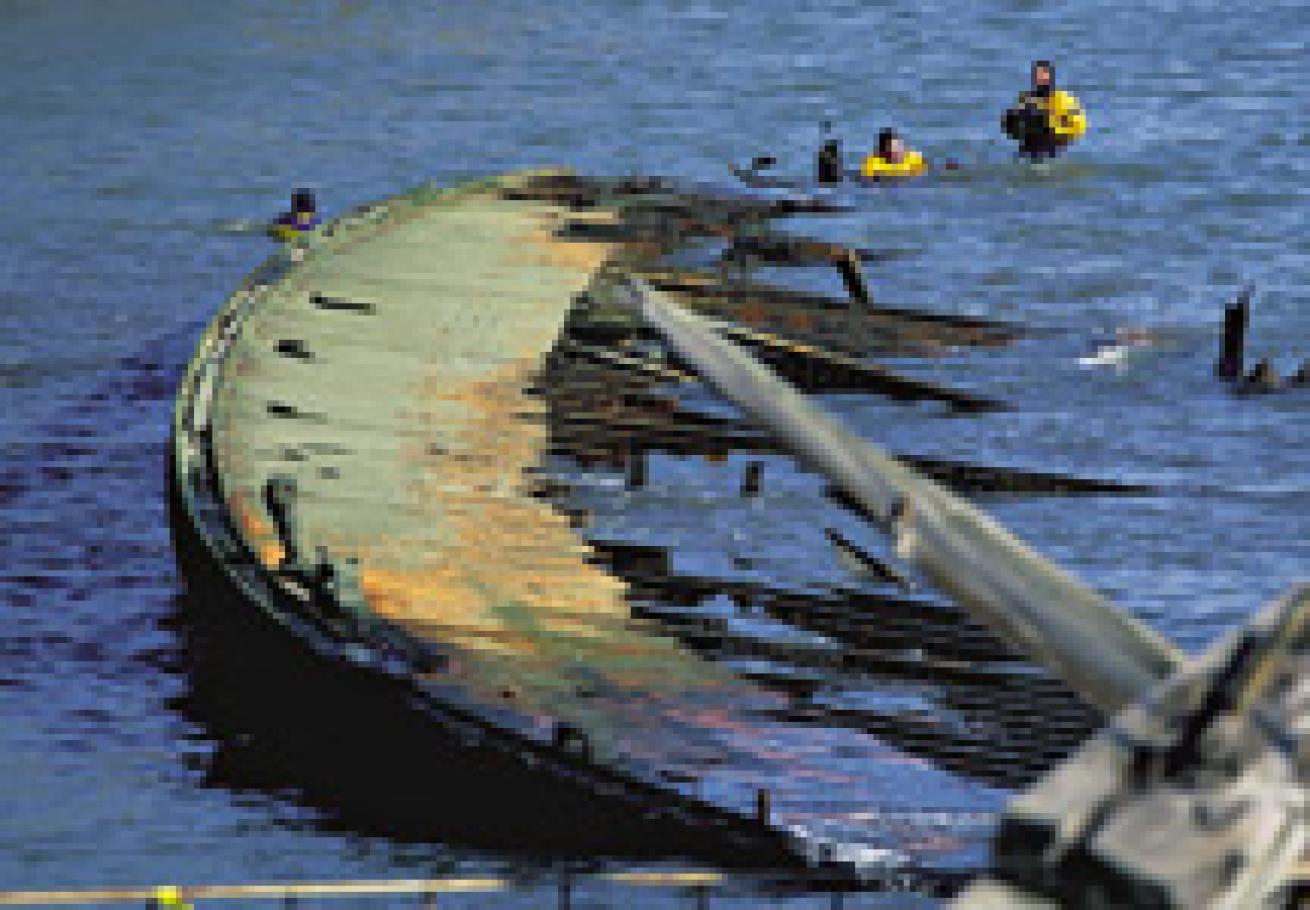
Photo: SRC divers take advantage of low tide to map the remains of the ferry Ellis Island.
It's a pretty weird dive site, Ellis Island National Monument, but I have to admit the topside scenery is spectacular. Hard by rises the verdigris-colored colossus of the Statue of Liberty. Beyond, in stunning chiaroscuro, juts the august complexity of the Manhattan skyline. And here comes another Circle Line ferry, packed with tourists, churning into the ferry channel. Blatting a Bronx cheer, the ferry docks along the seawall, while its wake rocks the floating dock where we're suiting up in body-condoms for a plunge into the confused and probably toxic water.
Ah, New York City — what a place to dive!
So maybe Ellis Island will never fly the "diver down" flag of recreational diving. Nonetheless, it's the resting place of a significant shipwreck, that of its own eponymous ferry, the Ellis Island, a workhorse of America's great immigrant experience. While Ellis Island (the buildings and grounds) undergoes a huge restoration — at $156 million so far, the costliest in U.S. history — the ferry Ellis Island lies in shallow water, showing a conspicuously disintegrating gunnel at low tide. Enter the National Park Service's elite underwater trouble-shooters, the Submerged Resources Center. Their mission: map the wreck and recommend what to do about it. It's a complex, dirty job — but nothing unusual for the SRC team.
"It's just like in a 'Doc Savage' novel," says Dave Conlin, the perpetually upbeat, 37-year-old SRC archeologist in charge of the ferry project. "There's Ox, the iron-muscled Norwegian, expert in demolitions ..."
"Actually, I'm the Sgt. Bilko of the outfit," photographer/videographer Brett Seymour jokes back. "I find ingenious ways to requisition all the latest cool gear."
Conlin's tongue is firmly in cheek, but like the fictional hero Savage and his band of improbably adept warriors, the SRC divers combine brain, brawn and technology to an impressive degree. He is "Doc" Conlin, after all, a Ph.D. in maritime archeology. His SRC partners here on Ellis Island, fellow maritime archeologist Matt Russell and Seymour, are also highly accomplished divers and experts at their specialties.
"It's a Passion"
|| |---|
|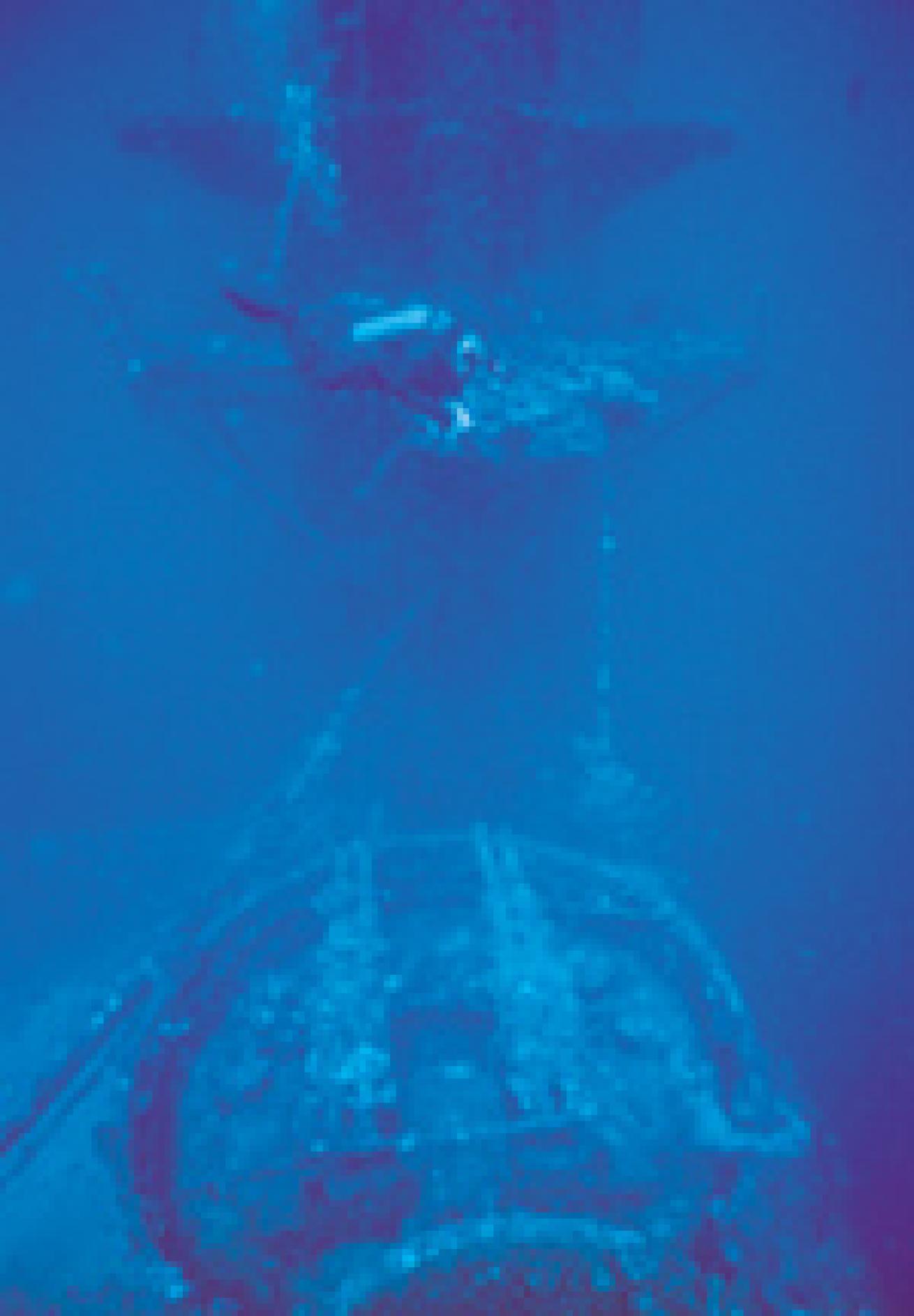
| | Dan Lenihan videotapes the bridge of the USS Saratoga at Bikini Atoll.|
Dressed in their green polyester ranger uniforms, the SRC divers travel the world — from Maine to Key Biscayne; from the California Channel Islands to the English Channel; from the Bering Strait to Micronesia — wherever and whenever they're needed.
Most have advanced degrees in archeology and anthropology, but team members must be highly skilled divers first and foremost. The SRC team responds to any situation under water, whether it's deep decompression diving with double tanks and Geiger counters to test for radioactivity at Bikini Atoll, or dry suit diving on wrecks under the ice of the Great Lakes, or searching the dark depths of a desert reservoir for a drowning victim.
Only the pace is constant: In an average year, SRC divers spend six months on the road together — as much as a hard-touring rock and roll band. And like rockers, they have great jobs and they know it.
"It's not a job, it's a commitment. It's a passion," says founder Daniel Lenihan, now semi-retired but still active with the unit. "If you don't have a little bit of outrageousness in you, you aren't going to make it in this team. We only know how to work full throttle. I suppose we could be reasonable about it, but then that wouldn't be the team."
As Russell changes out of his ranger duds and into the quilted long johns he'll wear under his dry suit, he tells me about some beautiful dives he did recently in Glacier National Park, on ferry wrecks from the turn of the last century. Besides the amazing diving, the thing Russell loves most about the job is the challenge of doing something difficult and doing it well.
And about this New York ferry we're about to dive?
"This one's challenging," Russell tells me, grinning.
From the Caves of Florida
|| |---|
|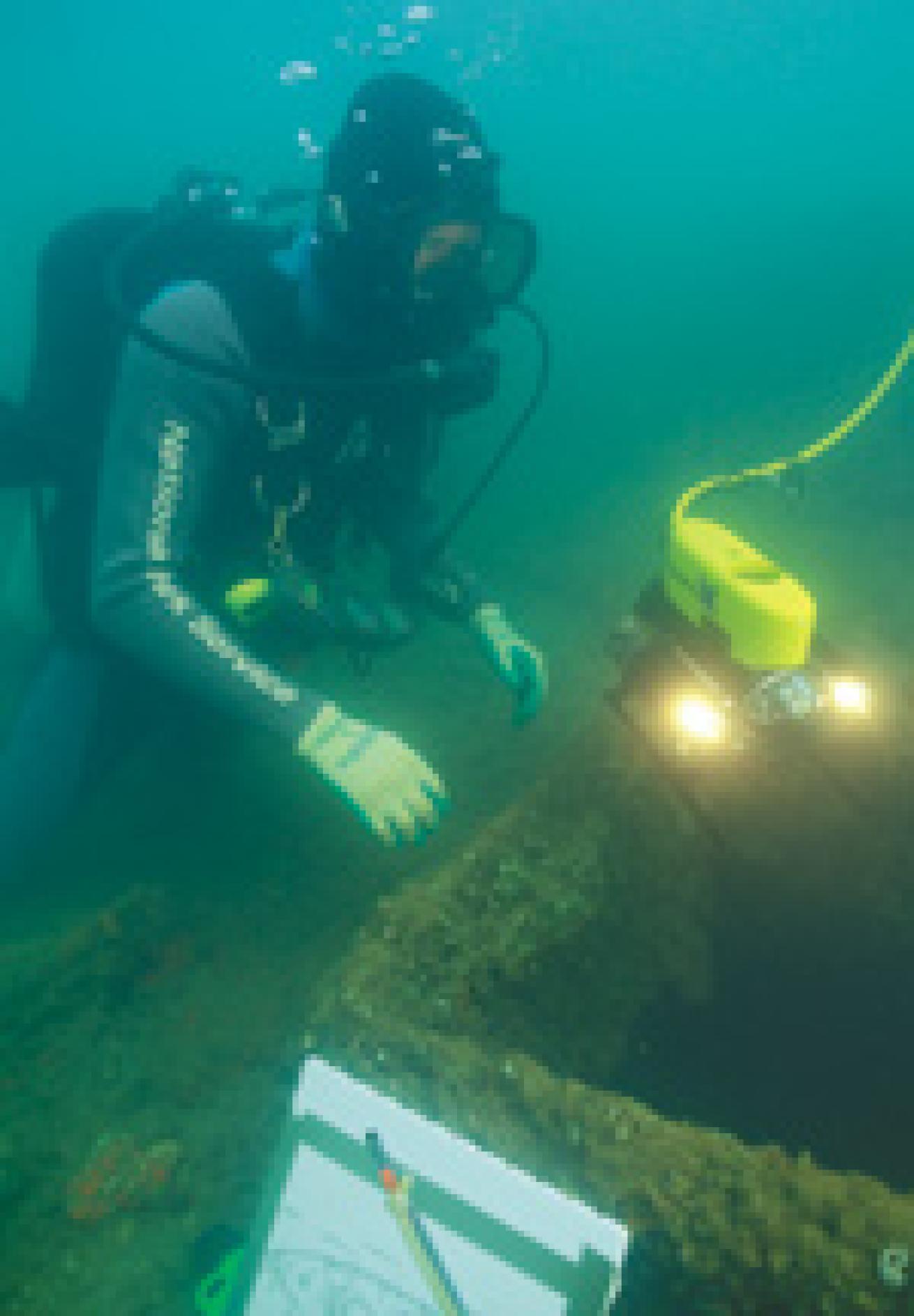
| | Out of respect for the sailors entombed inside the USS Arizona, the SRC team uses remotely operated vehicles to explore the wreck's interior.|
Murphy was a trained commercial diver and passionate underwater preservationist, who took cave training from Lenihan for his job with the state archeologist's office and became a convert to the cave cult.
They teamed up for the National Park Service in 1976 on a four-year underwater archeological survey of flooded reservoirs in the southwest, a project headed by Lenihan. The National Reservoir Inundation Study called for repetitive high-altitude diving in frigid, low-vis water. Lenihan, Murphy and the team they trained used cave diving techniques, cave diving discipline and even the same #18 braided-nylon line (standard issue in Florida caves) to guide them in the chilling murk.
The success of NRIS won Lenihan the job of directing a permanent team of diving rangers, the Submerged Cultural Resources Unit (with the beloved acronym S.C.R.U.), now the Submerged Resources Center. The SRC has since archeologized on such storied wrecks as the giant aircraft carrier Saratoga, sunk during A-bomb tests off Bikini Atoll. Their mission to map, illustrate and test the wreck-strewn site for radioactivity opened up one of the world's greatest playgrounds for advanced recreational divers.
An ongoing project of equal scope — but greater pathos — has been the SRC's study of the battleship Arizona in Pearl Harbor. The tomb of more than 1,000 young servicemen, the wreck also holds a large quantity of toxic Bunker C fuel oil that continues to weep a few drops at a time into the harbor water. Using tried-and-true tools — lines, tapes and brow-crinkling trigonometry — the SRC mapped the exterior (the largest underwater structure ever mapped in such exacting detail). Ongoing surveys of the interior employ state-of-the-art remotely operated vehicles (ROVs).
The SRC team also surveyed the wreck of the Civil War submarine H.L. Hunley, paving the way for one of the most complex and expensive recovery operations in the history of underwater archeology — raising and conserving the vessel intact.
In between headline-grabbing expeditions, SRC divers have also led risky body recovery missions (Lenihan and Murphy's dives inside the works of a Texas dam, described in Submerged, are about as scary as it gets); pioneered vehicular rescue techniques (when good boat launches go bad); certified scores of fellow NPS rangers (the SRC team are all diving instructors); been featured in documentaries by the BBC, National Geographic and The Discovery Channel, among others; and won academic prizes for their archeology along the way.
Esprit de Corps
|| |---|
|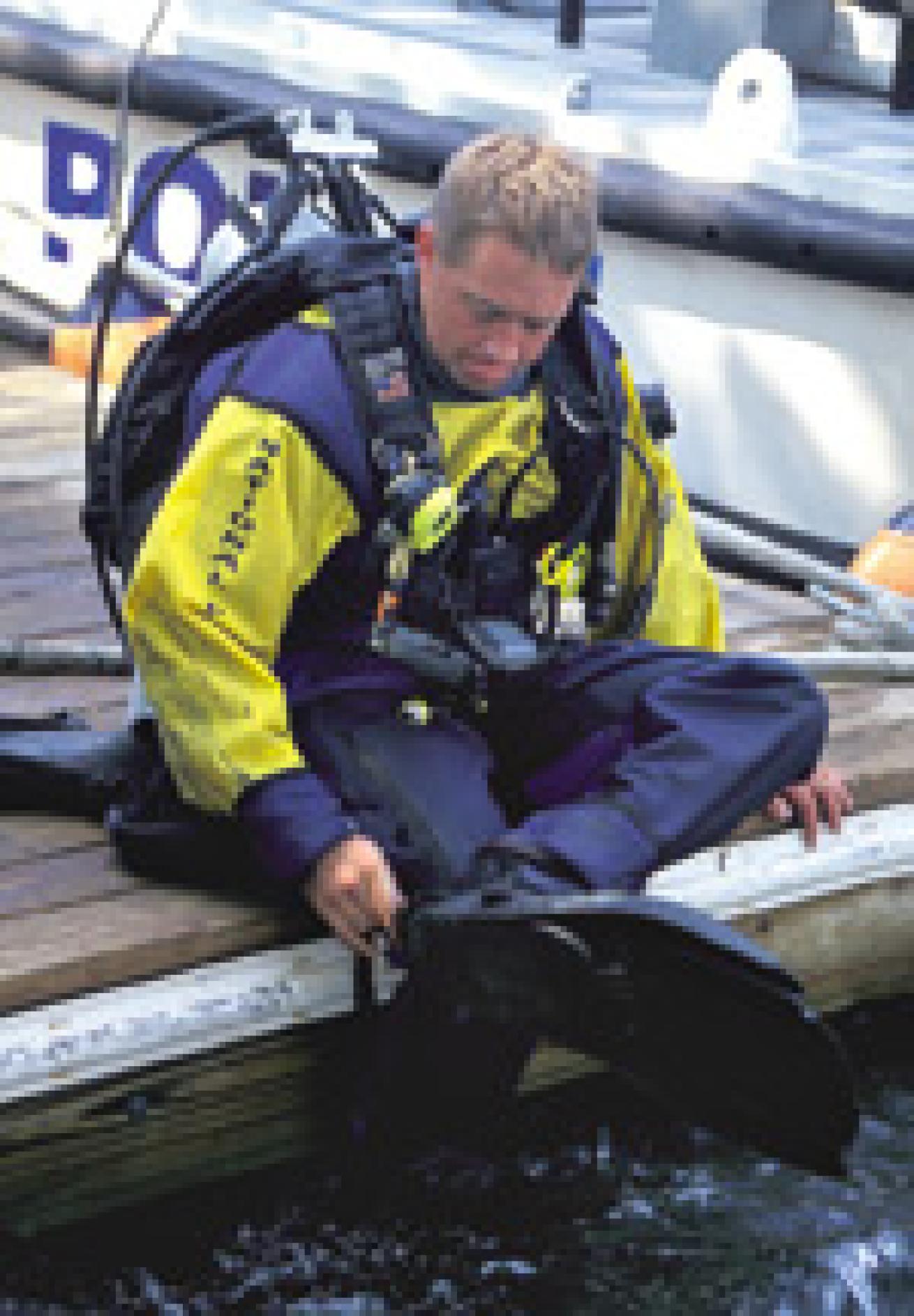
| | Suiting up: Dave Conlin prepares for another day in the murk of the abandoned ferry slip.|
The team I met one steamy morning in mid-July included five men in green: the three SRC guys, plus two veteran rangers on loan — Art Ireland, a nondiving surveying expert, and Jim Bradford, an artful underwater mapmaker. Rounding out the crew were interns Jackie Piero and general gofer Brendan Lenihan (Dan Lenihan's son), who was stoked to answer to "Copy Boy" so long as his duties also included diving.
They'd been hammering on the ferry project since April, and Conlin and Ireland were surveying the old broken pier that fans out from the ferry house. The wreck itself had been conceptually divided into 83 equal-sized panels. Jackie Piero and Jim Bradford were blowing bubbles in murk, plugging away with mapmaker's tape and slate at a panel in the high 70s. Brett Seymour and Brendan Lenihan dived in to recover artifacts. Matt Russell drew the short straw: media tour guide.
Swimming to Ellis Island
"Ready?" Russell asks. I flash the OK signal and we slip into the waters of the Golden Portal like a couple of wharf rats.
The near opacity of the ferry channel is immediately disorienting. We swim through untold shades of brown, bright caramel brown near the surface, with shining bits of particulate matter wildly swirling, a darker brown down deeper. Russell's flippers flee ahead of me in the gloom and I follow them like a remora. At 12 feet we kneel on the sucking mud of the bottom, which is very brown indeed.
Our full facemasks, equipped with two-way radios, allow us to converse.
RUSSELL: Well, this is it.
ME: Where?
RUSSELL: Right here, in front of us.
I move my face forward cautiously and — clunk! — there it is. A tiny patch of rusty hull is suddenly visible: craters of corrosion, a nut on a bolt. Move back a couple of inches and it's gone again. From the little I can see, I can't help thinking what a shame that it's come to this. The Ellis Island, a 140-foot, double-bowed passenger ferry, carried some 15 million striving souls from this ferry depot to the freedom, opportunity and laissez-faire mayhem of Lower Manhattan.
In 1954, the U.S. government abandoned Ellis Island — lock, stock and barrel-vaulted Registry Room. Just turned a key and walked. The Ellis Island rode out a decade of winter storms before listing terminally and hunkering down into the muck in 1968. A tropical storm in 1982 demolished the wooden superstructure, sweeping away much obvious historical charm. A mere shell now, it's all but lost to time.
Russell is currently mapping the boiler — panel #77 — which from what I can see of it looks like the business end of a cement mixer that's been stomped by Godzilla. It's shallow and surgy here, the boiler a jumble of rusty, sharp edges fading in and out of sight. The last couple of days Russell has spent long hours hovering above it with tape and slate, limning its every beat-up inch.
Unlike the three blind men in the famous Hindu parable of the elephant, these SRC guys are used to working by touch — and getting solid results. Dave Conlin tells a story about the Hunley mission. He and Matt Russell had to improvise a way to measure the diameter and shape of the hull, which lay five feet below bottom in a newly dredged hole in Charleston Harbor. The vis was zippo. He and Russell came up with a device — "a definite Rube Goldberg, Frankenstein's monster, PVC pipe kinda kludged together sort of deal, a real SRC special." Working blind and upside down with the contraption and a folding plastic ruler, Russell and Conlin came up with a hull height of four feet, three inches. That seemed awfully small; plus, the historical record stated that the sub was five feet high.
Four years later, Russell, Conlin and Seymour were back in Charleston when the Hunley was raised. "The sub broke the surface and was placed, unharmed, on a barge," recalls Conlin. "My overwhelming reaction was 'Damn, that thing is tiny.' Four feet, three inches tall, to be exact."
Yessiree, the SRC team is gonna know if it's an elephant all right, and there'll be a written report, an electronic data base, and a portfolio of photo and video images to back up the claim. What's even more impressive, though, is that they're going to recommend what to do about the brute.
A Form of Omniscience
"Dynamite it, right?" I say to Conlin. It's a couple of hours after my dive and I've had time to process all the data I need on the Ellis Island. "Cut it up with blow torches and haul it to deeper water."
Conlin chuckles indulgently. "Come on. I'll show you a little of what we've got."
I follow him into one of the wings of the restored Main Building to an upstairs room the SRC is using as its on-site office. Conlin sits at a laptop and starts clicking on icons.
There's Ellis Island, as seen from above, its man-made logic revealed — two islets, like the lobes of a brain, with the ferry channel neatly bisecting the two halves.
Click!
There's the ferry channel enlarged, with magnetometer readings overlaid, the lozenge-shaped ferry glowing in bright magenta.
Click!
There's an underwater view of the wreck, as pictured by side-scan sonar, peaks and valleys like an EEG.
Click!
There's the broken pier — a work in progress — rendered as a precision line drawing. An exact and complex portrait of pick-up sticks.
Conlin puts the program through a few more paces, rotating, enlarging, shrinking, showing various combinations of overlays. It's not quite omniscience, but a form thereof, and certainly a great deal more than I'd have guessed could be known about a blackwater wreck.
All in a Day's Work
It's late in the afternoon and everybody's out of the water. They're all about to pack up the gear and head for the office to download and debrief when a teacher approaches with about a dozen kids from a school for the deaf. The kids volunteered to do various jobs around the park, and Dave Conlin offered to give them a little demonstration of the project. The teacher translates with sign language as Conlin speaks.
"You'd all be good at this because we use a lot of signs under water," Conlin says. "Can you guess what this means?" He signs a few familiar ones. OK. Stop. Up. Then slashes his hand across his throat. There's a lot of laughter. Kids are signing like crazy. They know that one too.
Brett brings out his Nikon and lets them look through the lens. Matt writes on his erasable slate, shows them a few others crowded with data. One of the kids volunteers to try on a dry suit. Another, hooting with pleasure, dons a full facemask.
In a week or so, Brett will be joining up with Daniel Lenihan and some other rangers to dive the cold currents of the Pacific Northwest — an exploration trip. A little later, Matt's off to Hawaii and the challenge of the Arizona, still oozing bunker C fuel into Pearl Harbor. In the fall, Dave and the rest of the SRC crew is headed to the North Sea off the Yorkshire coast to look for the wreck of John Paul Jones's Bon Homme Richard.
Whatever their future adventures, I know I'm seeing the SRC at its multitasking best — doing preservation, facilitation, education, and just plain making friends with a curious public hungry for knowledge.
"Each project has its rewards," Conlin told me earlier, "and each one produces surprises. The things you think will be dramatic often turn out mundane, and the things you think will be boring can bring an unexpected charge of excitement."
I ask him if this is one of those latter cases and he says, "Yeah, this is a highlight. I'm going to remember this."
Then Jim Bradford unrolls the big paper map of the ferry — the work in progress. And it's a beauty, every broken strake lightly sketched, the progress of disintegration lovingly arrested. The kids look at the water, the bit of gunnel sticking up, then back to the map — amazed. They can't believe it.
Having seen and touched it myself, neither can I.
For More Info: [Submerged Cultural Resources Unit](Submerged Cultural Resources Unit )

